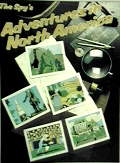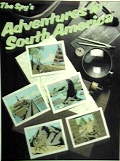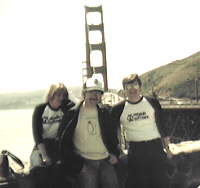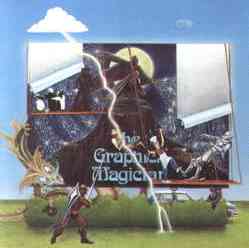Adventures Around the World



In 1984, we struck up a friendship with Steve and Marsha Meuse from the Boston area. Steve eventually programmed many of the Apple // double hi-res conversions for us, and he became our original expert on the Apple //c. Marsha was very much interested in computer graphics and program design. They were both interested in working on an original project, and Mark suggested an idea for some educational software since his background is actually in education (M.S. from the University of Illinois in "Educational Applications of Computers"), and he was ready to start moving the company in that direction.
He also had in mind developing another series besides the Comprehend adventures that could take advantage of portable Graphics Magician images, and which could be programmed in a way that would allow release across several platforms simultaneously, as with the Comprehend series. That would further free up Polarware from dependency on specific computer platforms.
 The idea that emerged was to create a computer game that would teach geography, much like
the board games Risk and Game of the States from long ago. Ideas were
bounced back and forth, but it was on a plane trip on April 23, 1984 from Boston to San
Francisco (with a stopover in Chicago) that the draft finally made it onto paper. The
flight was to the original announcement of the Apple //c computer. Steve and Marsha caught
the flight in Boston, and Mark joined them in Chicago. Between Chicago and San Francisco,
Marsha and Mark storyboarded the entire concept of a new series of educational games. (The
picture here is Mark with Marsha and Steve at the Golden Gate Bridge.)
The idea that emerged was to create a computer game that would teach geography, much like
the board games Risk and Game of the States from long ago. Ideas were
bounced back and forth, but it was on a plane trip on April 23, 1984 from Boston to San
Francisco (with a stopover in Chicago) that the draft finally made it onto paper. The
flight was to the original announcement of the Apple //c computer. Steve and Marsha caught
the flight in Boston, and Mark joined them in Chicago. Between Chicago and San Francisco,
Marsha and Mark storyboarded the entire concept of a new series of educational games. (The
picture here is Mark with Marsha and Steve at the Golden Gate Bridge.)
In the following months Marsha created the graphics and game text while Mark drafted the programming portion of the first game. Late in the year, preliminary copies were given to a few universities to run tests and provide comments and feedback as to their actual educational performance.
The game concept was similar to an "adventure" game and involved you as a spy, pursuing an evil villian around the continent. As you arrived at new locations, you were given clues to the location of the villian, along with information (a dossier) about the current location. If you paid attention to the dossiers, the clues would direct you to the appropriate destinations.
A key feature of the design was the user interface. Unlike a typical "adventure" game, at each location you'd be presented with a limited set of three or four choices. Two keys on the keyboard, SPACE and ENTER, would let you select your choice. This interface idea was pioneered by Al Lowe and Mike MacChesney, two teachers who had developed a couple of kids' adventures using The Graphics Magician. The games were Dragon's Keep and Troll's Tale (a key character in the latter was "King Mark"!). We really wanted to publish those games, but Al and Mike were from Fresno, a stone's throw from the headquarters of Sierra Software, who eventually published them. Al Lowe went on to fame as the author of many of Sierra's most successful programs in the late 80's and early 90's!
While early versions of Penguin's new Adventures in North America were in alpha testing, Mark was looking at sale or merger possibilities for the company. The hope was to let someone else handle the marketing end of the business, freeing us to work on the creative part of new software development. We seriously considered one possibility from a company for which we had the highest respect. In January 1985, in serious talks with that company, we exchanged financial information and long-term plans and Mark flew out to their headquarters to meet with them. Our new software in development was described in words to several key people at that company, and they showed what they currently had in development.
Nothing came of the potential sale/merger talks. But five months later at the Summer Consumer Electronics Show in Chicago, the other company displayed a prototype of one of their new software products... something that was not presented as "in development" back in January. It was the first public appearance of a prototype of the software called Where in the World is Carmen Sandiego?, which looked exactly like the verbal description of what we had in development. The president of the other company denied that he'd known that such a product had been in the works. "We exchange information with other companies just so something like this won't happen!" Yet, in the years to follow, slowly it would be the same president, as well as the other key people in the company with whom Mark had spoken, who would claim themselves as the inventors of the Carmen Sandiego series.
 Adventures Around the World instructions
Adventures Around the World instructions
|
 Adventures in North America, DSK archive
Adventures in North America, DSK archive
|
 Adventures in South America, DSK archive
Adventures in South America, DSK archive
|
 Adventures in Europe, DSK archive
Adventures in Europe, DSK archive
|
The original Carmen Sandiego series beat our Adventures Around the World series to market by about two months. We spent a lot of time testing and re-testing and getting the graphics and text just right, because it was an important series to us. Raimund Redlich and Brian Poff were creating truly amazing graphics to go along with each of the games. Marsha Meuse and Mark Glenn were researching and implementing all the educational materials within the games. The first releases were Adventures in North America and Adventures in Europe. We had six geographic games planned, followed by a series of time and planetary adventures. Our game was multiplayer (one to six people, competitive OR cooperative), and all the information was part of the game. Their game was single player, and it relied on external reference books. In head-to-head reviews in educational publications, ours came out as the better of the two.... But in early 1986 we also had three distributors either go bankrupt or stick us with heavy losses. We had virtually no money for an advertising budget for the first half of the year. Adventures in South America was released. Asia was almost done, Africa and Australia and the Pacific Islands were next. But everywhere we went, our series was seen as a "copy" of Carmen Sandiego! The shelf space for "educational geography games" was already taken...



